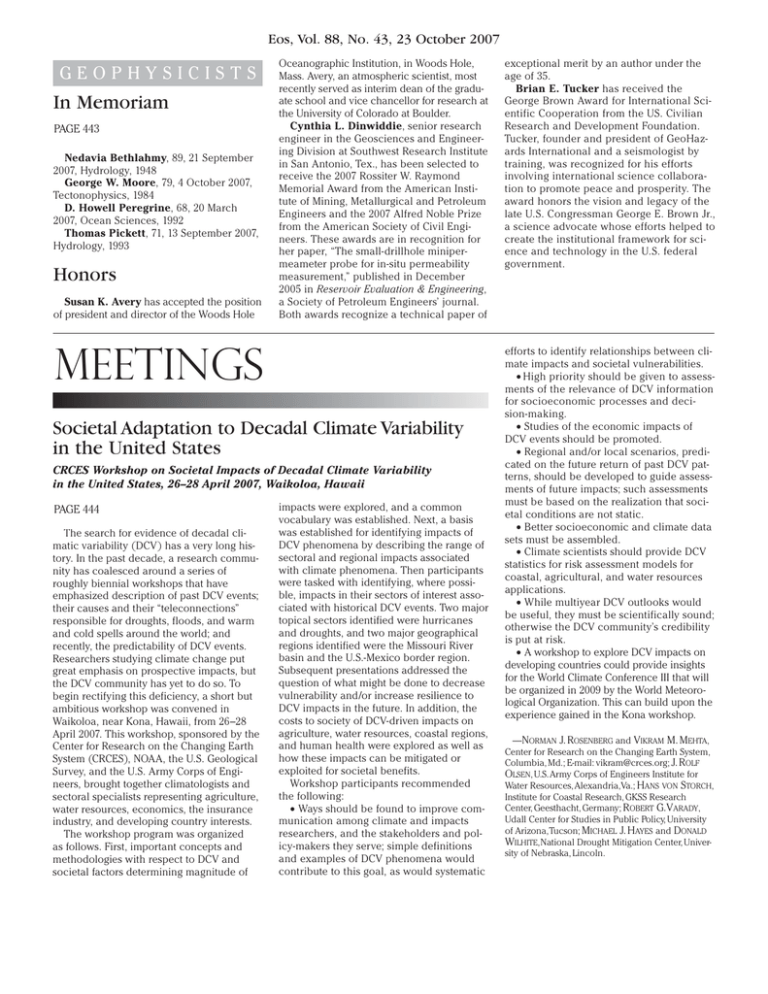G E O P H Y S I C I S... Eos, Vol. 88, No. 43, 23 October 2007
advertisement

Eos, Vol. 88, No. 43, 23 October 2007 GEOPHYSICISTS In Memoriam PAGE 443 Nedavia Bethlahmy, 89, 21 September 2007, Hydrology, 1948 George W. Moore, 79, 4 October 2007, Tectonophysics, 1984 D. Howell Peregrine, 68, 20 March 2007, Ocean Sciences, 1992 Thomas Pickett, 71, 13 September 2007, Hydrology, 1993 Honors Susan K. Avery has accepted the position of president and director of the Woods Hole Oceanographic Institution, in Woods Hole, Mass. Avery, an atmospheric scientist, most recently served as interim dean of the graduate school and vice chancellor for research at the University of Colorado at Boulder. Cynthia L. Dinwiddie, senior research engineer in the Geosciences and Engineering Division at Southwest Research Institute in San Antonio, Tex., has been selected to receive the 2007 Rossiter W. Raymond Memorial Award from the American Institute of Mining, Metallurgical and Petroleum Engineers and the 2007 Alfred Noble Prize from the American Society of Civil Engineers. These awards are in recognition for her paper, “The small-drillhole minipermeameter probe for in-situ permeability measurement,” published in December 2005 in Reservoir Evaluation & Engineering, a Society of Petroleum Engineers’ journal. Both awards recognize a technical paper of MEETINGS Societal Adaptation to Decadal Climate Variability in the United States CRCES Workshop on Societal Impacts of Decadal Climate Variability in the United States, 26–28 April 2007, Waikoloa, Hawaii PAGE 444 The search for evidence of decadal climatic variability (DCV) has a very long history. In the past decade, a research community has coalesced around a series of roughly biennial workshops that have emphasized description of past DCV events; their causes and their “teleconnections” responsible for droughts, floods, and warm and cold spells around the world; and recently, the predictability of DCV events. Researchers studying climate change put great emphasis on prospective impacts, but the DCV community has yet to do so. To begin rectifying this deficiency, a short but ambitious workshop was convened in Waikoloa, near Kona, Hawaii, from 26–28 April 2007. This workshop, sponsored by the Center for Research on the Changing Earth System (CRCES), NOAA, the U.S. Geological Survey, and the U.S. Army Corps of Engineers, brought together climatologists and sectoral specialists representing agriculture, water resources, economics, the insurance industry, and developing country interests. The workshop program was organized as follows. First, important concepts and methodologies with respect to DCV and societal factors determining magnitude of impacts were explored, and a common vocabulary was established. Next, a basis was established for identifying impacts of DCV phenomena by describing the range of sectoral and regional impacts associated with climate phenomena. Then participants were tasked with identifying, where possible, impacts in their sectors of interest associated with historical DCV events. Two major topical sectors identified were hurricanes and droughts, and two major geographical regions identified were the Missouri River basin and the U.S.-Mexico border region. Subsequent presentations addressed the question of what might be done to decrease vulnerability and/or increase resilience to DCV impacts in the future. In addition, the costs to society of DCV-driven impacts on agriculture, water resources, coastal regions, and human health were explored as well as how these impacts can be mitigated or exploited for societal benefits. Workshop participants recommended the following: • Ways should be found to improve communication among climate and impacts researchers, and the stakeholders and policy-makers they serve; simple definitions and examples of DCV phenomena would contribute to this goal, as would systematic exceptional merit by an author under the age of 35. Brian E. Tucker has received the George Brown Award for International Scientific Cooperation from the US. Civilian Research and Development Foundation. Tucker, founder and president of GeoHazards International and a seismologist by training, was recognized for his efforts involving international science collaboration to promote peace and prosperity. The award honors the vision and legacy of the late U.S. Congressman George E. Brown Jr., a science advocate whose efforts helped to create the institutional framework for science and technology in the U.S. federal government. efforts to identify relationships between climate impacts and societal vulnerabilities. • High priority should be given to assessments of the relevance of DCV information for socioeconomic processes and decision-making. • Studies of the economic impacts of DCV events should be promoted. • Regional and/or local scenarios, predicated on the future return of past DCV patterns, should be developed to guide assessments of future impacts; such assessments must be based on the realization that societal conditions are not static. • Better socioeconomic and climate data sets must be assembled. • Climate scientists should provide DCV statistics for risk assessment models for coastal, agricultural, and water resources applications. • While multiyear DCV outlooks would be useful, they must be scientifically sound; otherwise the DCV community’s credibility is put at risk. • A workshop to explore DCV impacts on developing countries could provide insights for the World Climate Conference III that will be organized in 2009 by the World Meteorological Organization. This can build upon the experience gained in the Kona workshop. —NORMAN J. ROSENBERG and VIKRAM M. MEHTA, Center for Research on the Changing Earth System, Columbia, Md.; E-mail: vikram@crces.org; J. ROLF OLSEN, U.S. Army Corps of Engineers Institute for Water Resources, Alexandria,Va.; HANS VON STORCH, Institute for Coastal Research, GKSS Research Center, Geesthacht, Germany; ROBERT G.VARADY, Udall Center for Studies in Public Policy, University of Arizona, Tucson; MICHAEL J. HAYES and DONALD WILHITE, National Drought Mitigation Center, University of Nebraska, Lincoln.









